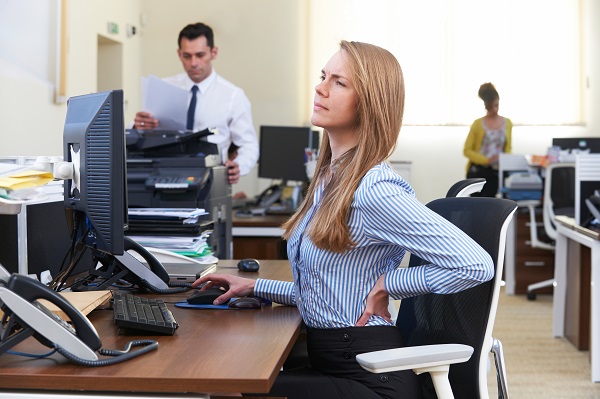“I experience back pain while sitting, what should I do?”
Do you find that you are constantly fidgeting when you are sitting? Do you dread sitting because it is going to hurt your back? Have you tried all kinds of different chairs, hoping to find one that is comfortable, without much luck? Have you found that even when you sit with perfect posture, sitting still bothers your back?
Despite the bad rap it sometimes gets, sitting is not all bad. In fact, we not only like sitting (at least sometimes), our bodies are also designed for sitting.
That does not mean that sitting always feels great though. Sometimes sitting can be quite painful.
However, there are often things you can do and changes you can make to your sitting habits to reduce and alleviate that pain.
Here are 6 tips to help make sitting as comfortable as possible.
1. Use a lumbar pillow.
The back pain we get from sitting is often from sitting with our backs flexed or rounded (aka the slouched position). Sitting in this way increases the strain on your low back, increasing your chances of having pain. A lumbar pillow helps to prevent this flexed position and keeps your low back in a relaxed natural curve. This reduces the amount of strain on your low back, helping to reduce or alleviate your pain. See a more in-depth discussion about the value and use of lumbar pillows here.
2. Use the backrest of your chair.
Sitting without a backrest requires the muscles of your back, and usually your hips as well, to constantly be working. This leads to unnecessary muscle fatigue and spine compression, both of which can increase your back pain. However, when you use your chair’s backrest, your muscles can turn off, reducing or alleviating your pain. This is why, for most people with back pain, I do not recommend sitting on a gym ball. Sitting on a gym ball increases the muscle activity of your back and core muscles, increasing your likelihood of experiencing muscle fatigue and pain.
3. Keep the front of your seat lower than the back.
A forward angulated seat pan helps to reduce low back rounding. Like a lumbar pillow, this helps to keep your low back in a relaxed natural curve instead. As such, this also helps to reduce or alleviate pain while sitting.
4. Frequently change your position.
Often we have this idea that there is an ideal sitting posture. Usually it is described as sitting tall in your chair with your feet flat on the floor and with your knees and hips bent at 90 degrees. The problem is that any posture, even this so-called ‘ideal one’, should not be sustained for long periods of time. Any posture, even the so-called ‘best’ ones, when sustained for long periods of time will start hurting. Rather than one perfect posture, the ideal posture is a variable posture. Frequently changing your posture, even slightly, every 10 minutes or so will allow the strain of sitting to migrate between tissues in your low back, reducing the likelihood of pain and injury.
5. Remove wallets, phones, etc. from your back pocket.
Sitting on items in your back pocket, especially for long periods of time is never a good idea. Doing this creates pressure points, increasing the risk of irritation to your sciatic nerve and hip.
6. Get out of your chair frequently.
Get up every 20-30 minutes, or less if your back starts to bother you in less time than that.
The best way to reduce back pain from sitting is to avoid sitting for too long. Get up and move around or stretch towards the ceiling regularly, even if it is only for 30 seconds, before your back starts to bother you. For many people with back pain, this would mean getting up every 20-30 minutes. If your pain begins more quickly than that, get up more often. If you can easily last that long, still try to get up at least every 50 minutes.
Remember that when it comes to sitting, as in so many other things, moderation and variety are key. Too much of anything, even a good thing, usually is not good.

